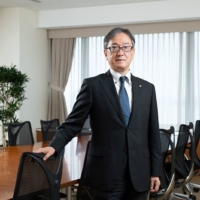A Japanese research team has discovered what appears to be tomb artifacts at Daisen Kofun, the country's biggest ancient tumulus purportedly for Emperor Nintoku, in the city of Sakai, Osaka Prefecture.
The kondosotosu iron knife and pieces of armor have been confirmed to be from the keyhole-shaped grave mound, a World Cultural Heritage site, the team said Thursday. The group comprises members of the city government, Kokugakuin University and Nippon Steel Technology.
"It's significant that objects directly linked to (the tumulus) have appeared," Kokugakuin University professor Takashi Uchikawa said.
According to the group, armor and other items were found at the tumulus early in the Meiji Period (1868-1912). Most of them are believed to have been buried again, but some were owned by antiquarian Kaichiro Kashiwagi when he was alive during the Meiji Period. The university bought the collection last year.
A drawing by Kashiwagi suggests that armor was among the burial items in the tumulus, but no physical evidence had been confirmed until now.
The excavated knife has features, including the use of gold-plated copper sheets and silver rivets, that had not been seen before in grave artifacts from the fifth century, when the tumulus was created. Given the items' quality, the knife is very likely to have belonged to someone close to an early king of Japan, according to the team.
Pieces of paper dated September 1872 that are believed to have been wrapped around the knife and the armor pieces have also been found, featuring descriptions saying that the tumulus is Emperor Nintoku's tomb.




















With your current subscription plan you can comment on stories. However, before writing your first comment, please create a display name in the Profile section of your subscriber account page.